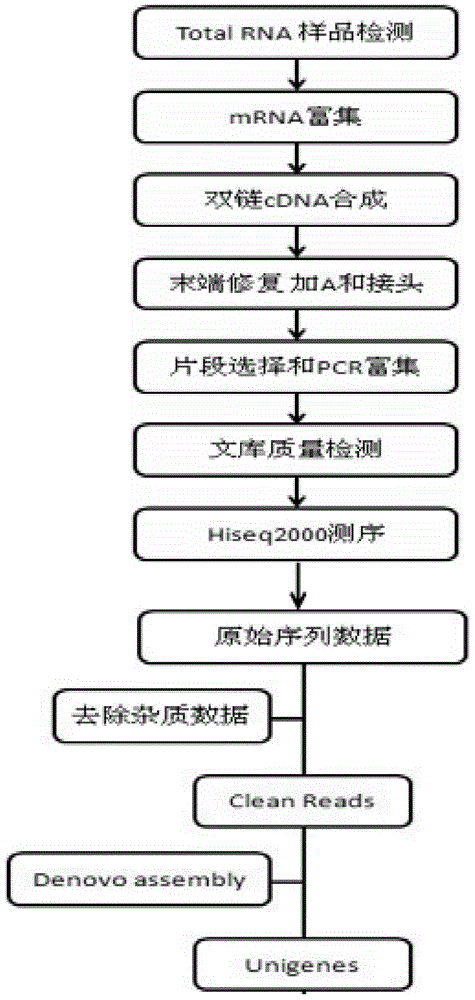Method for sequencing and development of Asplenium nidus L. EST-SSR primers based on transcriptome
A technology of transcriptome sequencing and bird's nest fern, applied in the field of molecular biology, can solve the problem of limited number of SSR primers, achieve the effect of real and reliable results, save time and money, and improve development efficiency
- Summary
- Abstract
- Description
- Claims
- Application Information
AI Technical Summary
Problems solved by technology
Method used
Image
Examples
Embodiment 1
[0095] Example 1 : Acquisition of transcriptome sequence data and design of EST-SSR primers
[0096] 1. Acquisition of transcriptome data:
[0097] The total RNA of bird's nest fern leaves was extracted by TRIzoL method, purified, and treated with DNase to obtain TotalRNA samples with a total amount ≥ 5 μg and an OD260 / 280 of 1.8-2.2, which were quickly frozen in liquid nitrogen and stored at -70°C for later use; RNA samples were detected by AgiLent2100 BioanaLyzer , extract RNA samples with a quality RIN value ≥ 7.0 for library construction;
[0098] Use magnetic beads with Oligo(dT) to enrich the mRNA with polyA, then use ultrasound to break the mRNA into short sequences, and recover 200-700bp fragments;
[0099] Using mRNA as a template, use six-base random primers to synthesize the first cDNA strand, then add buffer, dNTPs, RNaseH and DNApolymeraseI to synthesize the second cDNA strand; the cDNA is purified by the kit and eluted with EB buffer to make the end Repair, a...
Embodiment 2
[0112] Example 2 : Mining of EST-SSR loci in Bird's nest fern
[0113]The fern bird's nest fern was used as the experimental material, and the leaves of bird's nest fern were collected for transcriptome sequencing. A total of 42,907 EST sequences were obtained by sequencing. After removing redundancy, a total of 6,067 EST-SSR sites were detected, distributed among 5,178 EST sequences. Accounting for 12.07% of the total; the EST-SSR types of Bird’s nest fern are abundant, and dinucleotide, trinucleotide and mononucleotide are the dominant repeat types, accounting for 81.62% of the total EST-SSR, see Table 1; Bird’s nest fern EST- In SSR, a total of 106 motif types were observed, and the motif types of mononucleotide to hexanucleotide repeat types were 2, 4, 18, 21, 23, and 38, see figure 2 ;Among them, AG / CT has the highest frequency of 1371, accounting for 22.60%; followed by CA / GT, with a total of 1066, accounting for 17.57%; A / T, a total of 628, accounting for 10.35%; G / C...
Embodiment 3
[0120] Example 3 : Polymorphism Identification of 10 Fern Material DNA Using EST-SSR Primers
[0121] Genomic DNA was extracted from 10 fern materials, and its quality was detected by 0.8% agarose gel electrophoresis. The DNA concentration was diluted to 50 ng / μL and stored at -20°C for later use. Use the DNA of the materials used for primer development to carry out PCR identification of the success rate of primer design; the total volume of the PCR reaction system is 20 μL, which includes 2.0 μL of 10×PCR buffer and 25 mmol / L of Mg 2+ 1.6 μL, 2.5 mmol / L dNTPs 1.8 μL, 10 μmol / L SSR primer 1.0 μL, 30 ng / μL genomic DNA 2.0 μL, 2.5U / μL TaqDNA polymerase 0.2 μL and ddH 2 O11.4μL; PCR amplification program: 94°C pre-denaturation for 3min; 94°C denaturation for 30s, 50-60°C annealing for 45s, 72°C extension for 1min, 32 cycles; 72°C extension for 10min; 4°C storage; after the reaction, Add 2 μL of Loadingbuffer to the PCR product, and use 8% polyacrylamide gel for electrophoresis...
PUM
 Login to View More
Login to View More Abstract
Description
Claims
Application Information
 Login to View More
Login to View More - R&D
- Intellectual Property
- Life Sciences
- Materials
- Tech Scout
- Unparalleled Data Quality
- Higher Quality Content
- 60% Fewer Hallucinations
Browse by: Latest US Patents, China's latest patents, Technical Efficacy Thesaurus, Application Domain, Technology Topic, Popular Technical Reports.
© 2025 PatSnap. All rights reserved.Legal|Privacy policy|Modern Slavery Act Transparency Statement|Sitemap|About US| Contact US: help@patsnap.com



